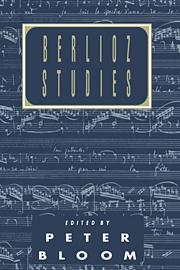Book contents
- Frontmatter
- Contents
- Preface
- List of abbreviations
- 1 The Reboul-Berlioz Collection
- 2 Berlioz and the metronome
- 3 Romeo and Juliet and Roméo et Juliette
- 4 In the shadows of Les Nuits d'été
- 5 Les Nuits d'été: cycle or collection?
- 6 ‘Ritter Berlioz’ in Germany
- 7 The Damnation of Faust: the perils of heroism in music
- 8 Berlioz's version of Gluck's Orphée
- 9 Overheard at Glimmerglass (‘Famous last words’)
- Index
2 - Berlioz and the metronome
Published online by Cambridge University Press: 14 September 2009
- Frontmatter
- Contents
- Preface
- List of abbreviations
- 1 The Reboul-Berlioz Collection
- 2 Berlioz and the metronome
- 3 Romeo and Juliet and Roméo et Juliette
- 4 In the shadows of Les Nuits d'été
- 5 Les Nuits d'été: cycle or collection?
- 6 ‘Ritter Berlioz’ in Germany
- 7 The Damnation of Faust: the perils of heroism in music
- 8 Berlioz's version of Gluck's Orphée
- 9 Overheard at Glimmerglass (‘Famous last words’)
- Index
Summary
In his Memoirs Berlioz recounts an exchange with Mendelssohn that took place in Rome in 1831. ‘What on earth is the point of a metronome?’ Mendelssohn had asked; ‘Any musician who cannot guess the tempo of a piece just by looking at it is a duffer.’ Berlioz said nothing, but later enjoyed Mendelssohn's annoyance when, looking at the newly completed manuscript of the Roi Lear Overture, Mendelssohn turned to Berlioz and said ‘Give me the right tempo’. ‘What on earth for?’ replied Berlioz, ‘I thought you said that any musician who couldn't guess the tempo was a duffer?’
Unlike Mendelssohn and Brahms, who also scorned the metronome, Berlioz approved of it and used it all his life. A passage in Le Chef d'orchestre confirms his faith and offers a judicious note of caution:
If a conductor is not in a position to have received instruction directly from the composer or if the tempos have not been handed down by tradition, he must look to the metronome marks and study them carefully, since most composers today take the trouble to write them in at the beginning and in the course of their pieces.
I do not mean to imply that he must copy the metronome's mathematical regularity; any music done that way would be stiff and cold, and I doubt that one could maintain such level uniformity for many bars. But the metronome is, all the same, excellent to consult to establish the opening tempo and its main changes.
- Type
- Chapter
- Information
- Berlioz Studies , pp. 17 - 36Publisher: Cambridge University PressPrint publication year: 1992
- 1
- Cited by



